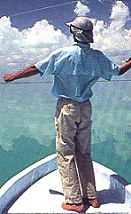|
For most of us learning to fly-cast is a self-taught thing. Many came up
through the ranks of casting, or spinning to fly fishing. Both of those are
fortunately easy to master. Fly-casting does add some new elements to
the game that sometimes seem to escape some of us. Over several years
of teaching fly-casting we have seem many examples of how spinning and
fly-casting can interfere with each other.
Usually a person only gets as good at fly-casting as needed. Not much point
in getting any better at it. The problem seems to be a mix of spinning and
fly-casting results as a product of the self-taught matter. The fly-casting still
contains some, and often harmful, elements of spinning. In teaching fly-casting,
these are the difficult things for an instructor to remove. The elements were
fine for spinning, but not necessarily for fly-casting.
For instance, you have found when you are using a rather heavy spinning lure,
it may be better to lob, or swing the lure forward instead of just firing it out with
the tip of the rod. To do so may break the lure off, or damage the rod tip. If you
do much of this type of spinning you will develop a style of casting that will put
your right foot behind you and lets your right shoulder do a lot of the casting. Not
brain-surgery, it just works well that way.
This style, although not in any way wrong for fly-casting, (more on that later)
can cause you to lob, or swing the fly rod in the same way; which does not
work especially well. This swinging will severely limit the distance of your cast
and the ability to form the type of loops you need. However, you can fish
short distances with enough success to perhaps never change it at all.
The problem develops when you decide you would like to cast farther, or
with tighter loops. The obvious answer is to simply lob, or swing the rod
harder. Not so. If the method is only partly correct for short distances,
doing it harder will only magnify the errors. Frustration sets in and you
give up the attempts at longer casting.
There is something that you can try that may help immediately. We have
seen it work wonders at times. I think it may in some way, short-circuit the
brain and allow you to cast using the rod, not your shoulder. Try this for
more distance. Put both feet side-by-side, the soles touching each other.
Now make your casts while standing as straight and tall as you can. Yes,
shoulders back, suck in that gut, imagine someone is going to take a picture
of you doing it.

While you are concentrating on all of those things make as 'classy' fly-casts
as possible. Remember, you are now trying to teach your right arm something
it may never have done before. Make it good, don't mess up the chance.
You should see a great improvement in the ability to form and control both
the front and back loops. If you need to see where the back loop is going
(it is longer now), turn and look more up rather than back. At this point if
you start to turn sideways to watch the back loop you may start to drop
the right shoulder. Not a good thing right now.
Next week I will try to pick you up at this point. For right now, work hard
to make every practice cast as good as you can. Stand tall, firm wrist,
shoulders back, gut in. ~ JC
Till next week, remember ...
|



